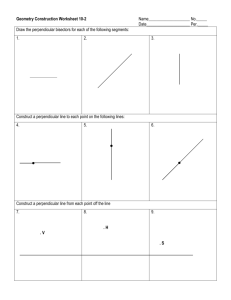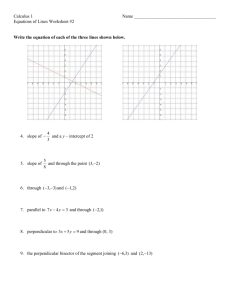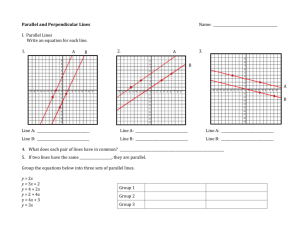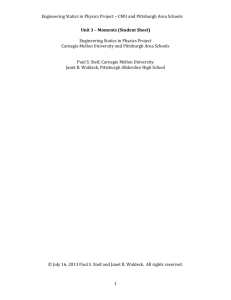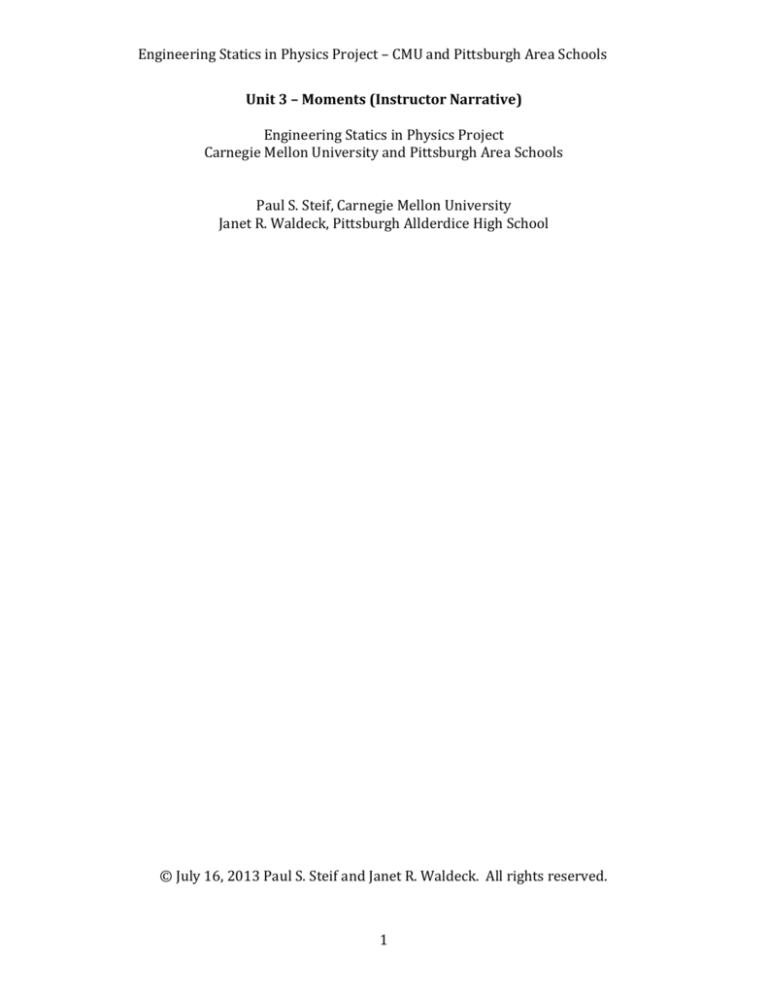
Engineering Statics in Physics Project – CMU and Pittsburgh Area Schools
Unit 3 – Moments (Instructor Narrative)
Engineering Statics in Physics Project
Carnegie Mellon University and Pittsburgh Area Schools
Paul S. Steif, Carnegie Mellon University
Janet R. Waldeck, Pittsburgh Allderdice High School
© July 16, 2013 Paul S. Steif and Janet R. Waldeck. All rights reserved.
1
Engineering Statics in Physics Project – CMU and Pittsburgh Area Schools
3.1 Tendencies of forces to rotate a body constrained to pivot about a point
A “moment apparatus” (an L-shaped structure that pivots about a rod) will be used
to practice quantifying the tendency of forces to rotate a body about a point. The
moment due to a force about a point is the tendency of the force to cause a
body to rotate about that point. Students will examine three experimental
configurations: (i) with the applied force perpendicular to the arm attached to the
pivot, (ii) with the applied force parallel to the arm, and (iii) with the applied force
at an angle with respect to the arm.
LEARNING OBJECTIVE: Students will be able to measure the force which causes a
body to rotate about a given point and the moment arm associated with that force.
They will be able to use these values, the force and moment arm, to compute the
moment (sometimes called torque) due to the force.
Apply a force with the spring scale to each of the different hooks on the “L” of the
moment apparatus. In response to the applied force, the “L” rotates. Try to pull
hard enough so that the L lies perpendicular to the base and the two lines marked
on the apparatus are aligned.
When you pull the L with the spring scale, notice that two forces exert opposing
tendencies to rotate the L about the pivot rod: that due to the spring scale and that
due to a counter spring in the apparatus itself. If the L is always rotated to the same
location, the tension exerted by the counter spring in the apparatus always has the
same magnitude. Thus the counter-spring, stretched by the same amount and
having the same orientation and attachment point in each trial, provides the same
tendency to rotate the L.
When you apply a force with the spring scale and hold the L in a fixed position, it is
in equilibrium. So, your spring scale force produces a tendency to rotate exactly
opposite to that of the counter spring. It is like two people pushing on opposite faces
of a door and the door not rotating.
2
Engineering Statics in Physics Project – CMU and Pittsburgh Area Schools
(i) with the applied force perpendicular with the arm attached to the pivot:
For each of the hooks shown, measure the force needed to make the arm attached to
the pivot rotate so it is perpendicular to the base. Measure the perpendicular
distance for each force and compute the moment due to each force about the rod
(force times perpendicular distance).
F
E
A
Hook
A
B
C
D
E
F
Force
B
Perpendicular distance
3
C
D
Moment
Engineering Statics in Physics Project – CMU and Pittsburgh Area Schools
(ii) with the applied force parallel to the arm attached to pivot arm: Measure
the force needed to make the L perpendicular to the base when applied to each of
the hooks as shown. Measure the perpendicular distance for each force and compute
the moment due to each force about the rod (force times perpendicular distance).
F
E
Hook
E
F
Force
Perpendicular distance
4
Moment
Engineering Statics in Physics Project – CMU and Pittsburgh Area Schools
(iii) with the applied force at an angle with respect to the arm: In this
experiment, the force is applied, to hook F, at an angle θ with respect to the
horizontal. Measure the force needed to make the L perpendicular to the base when
the angle is 30, 45, and 60.
For each angle, measure the perpendicular distance. This is the distance from the
pivot rod to the line through the force - it may be challenging to measure this
distance accurately. Then, compute the moment due to the force about the rod
(force times perpendicular distance).
Next, for each angle, resolve the applied force into its horizontal and vertical
components. Measure the perpendicular distance associated with each component
and compute the moment contributed by each component. Sum the two moments
and compare this result with the moment determined by the unresolved force.
F
5
Engineering Statics in Physics Project – CMU and Pittsburgh Area Schools
Angle
Force
Perpendicular distance
Moment
Force Comp
Perpendicular distance
Moment of Force Comp
30
30
30
Total Moment
30
Force
Perpendicular distance
Moment
Force Comp
Perpendicular distance
Moment of Force Comp
45
45
45
Total Moment
45
Force
Perpendicular distance
Moment
Force Comp
Perpendicular distance
Moment of Force Comp
60
60
60
Total Moment
60
6
Engineering Statics in Physics Project – CMU and Pittsburgh Area Schools
3.2 Direction of rotation produced by a force
Students will examine the tendency of an applied force to cause rotational motion
for a body pivoted about a point. Students will observe the sense of rotation that
results, as the direction of the force is varied.
LEARNING OBJECTIVE: Students will be able to explain how the direction of the
rotation of an applied force affects the direction of rotation about a pivot point.
Place an L-shaped body so rests freely on a horizontal surface such as a table or the
floor. While pressing with a finger on one corner (the pivot), loop a piece of string
to the far hook. When the direction of the applied force is varied, observe the
resulting sense of rotation: clockwise or counterclockwise. Find the angle of the
force that produces no rotation.
Press down lightly
with finger here to
allow pivoting about
this point
7

